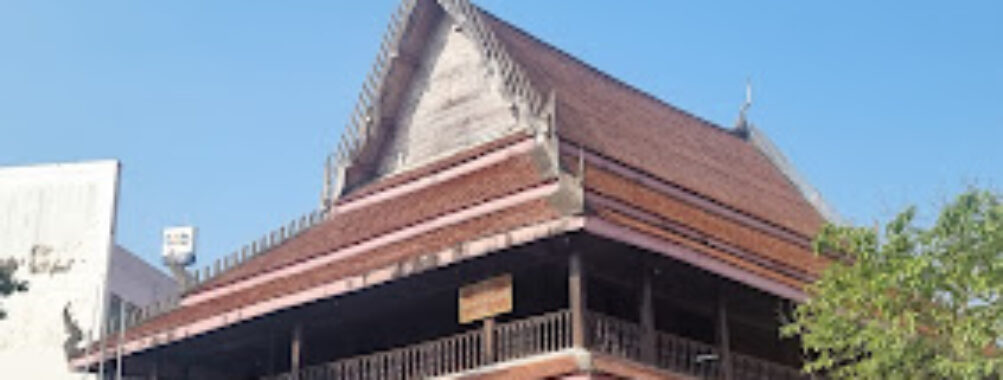
Wat Sai Museum
Table of Contents
Description
Wat Sai Museum in Surat Thani is one of those places that quietly surprises you. It’s not a massive, flashy museum with endless halls, but rather a small, intimate space tucked inside the grounds of a historic temple. And honestly, that’s what makes it so special. The museum gives you a chance to slow down and really take in the cultural heartbeat of Southern Thailand. Inside, you’ll find relics that date back generations—ancient manuscripts, ornate monk’s seats, temple bells from the Rama III era, and even golden Buddha statues that glimmer softly in the wooden hall. The building itself has a story too: constructed in 1932, it was once occupied by Japanese troops during World War II, which adds another fascinating layer to its history.
Walking through the museum feels less like being in a formal gallery and more like stepping into someone’s carefully preserved memory box. The exhibits aren’t overwhelming, and that’s part of the charm—you can take your time, notice the details, and actually enjoy what you’re looking at instead of rushing past. Families often find it approachable, and kids usually enjoy spotting the quirky artifacts, while history buffs can dive deep into the significance of the Buddhist relics. The atmosphere is calm, almost meditative, and yet there’s a sense of curiosity in the air. It’s not perfect—some displays show their age, and the information isn’t always as detailed as you might wish—but that rawness makes it feel authentic rather than curated to perfection.
For me, the museum is best described as a hidden gem for travelers who want to connect with local heritage without the crowds. It’s not trying to be grand, but it doesn’t need to. It’s the kind of place where you leave feeling like you’ve uncovered a story that most people passing through Surat Thani never even realize exists.
Key Features
- Collection of ancient Buddhist relics, manuscripts, and ceremonial items
- Historic wooden hall dating back to 1932 with intricate carvings
- Artifacts tied to the Japanese occupation during World War II
- Golden Buddha statues and ornate monk’s seats on display
- Wheelchair accessible restroom and general visitor amenities
- Family-friendly environment, suitable for children
- Quiet, reflective atmosphere away from tourist-heavy attractions
Best Time to Visit
The best time to visit Wat Sai Museum is during the cooler months from November to February. The weather in Surat Thani is more forgiving then, making it easier to explore both the temple grounds and the museum without feeling drained by the heat. Mornings are particularly peaceful, with soft light filtering through the wooden hall and fewer visitors around. If you prefer a livelier atmosphere, late afternoons sometimes bring in local families and curious travelers. Avoid midday if you’re sensitive to heat, as the tropical sun can make even short walks feel exhausting. And if you happen to be in town during a Buddhist festival, the temple grounds around the museum take on an extra layer of energy and tradition that’s worth experiencing.
How to Get There
Getting to the Wat Sai Museum is fairly straightforward if you’re already in Surat Thani city. The temple complex sits in the old town, so it’s easily reached by tuk-tuk, songthaew (shared taxi), or even a rented scooter if you’re comfortable navigating Thai traffic. For those who prefer convenience, a private taxi is the simplest option and won’t break the bank. If you’re coming from the train station or the airport, expect a short ride of about 15–20 minutes depending on traffic. The roads leading to the museum are well-paved, and once you arrive, the temple grounds are easy to walk around. Just keep in mind that parking can be limited during busy times, so arriving earlier in the day is smart.
Tips for Visiting
First things first—dress respectfully. Since the museum is part of a functioning Buddhist temple, modest clothing is expected. Think covered shoulders and knees. Comfortable shoes are also a good idea, as you’ll likely want to wander around the temple grounds after visiting the museum. Don’t rush through; even though it’s a small space, the details in the woodwork and artifacts are worth pausing over. If you’re traveling with kids, encourage them to look for the unusual items like the brass bell or the decorative monk’s seats—it keeps them engaged and makes the visit fun for them too.
Photography is generally allowed, but always double-check for signs and remember to be discreet. Flash photography can be disruptive, especially in a spiritual setting. Bring a bottle of water, but avoid eating or drinking inside the museum itself. And here’s a little personal tip: strike up a conversation with one of the caretakers if you get the chance. Even with limited English, they often share small stories or insights that you won’t find on any information board. Those moments can make your visit feel more personal and memorable.
Lastly, don’t expect perfection. Some displays may feel a bit worn, and not every artifact has a detailed description. But that’s part of the charm—it feels real, not overly polished. If you go in with an open mind and a bit of curiosity, Wat Sai Museum can easily become one of the most rewarding stops on your Surat Thani journey.
Location
Places to Stay Near Wat Sai Museum
Find and Book a Tour
Explore More Travel Guides
No reviews found! Be the first to review!